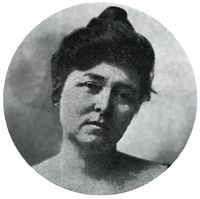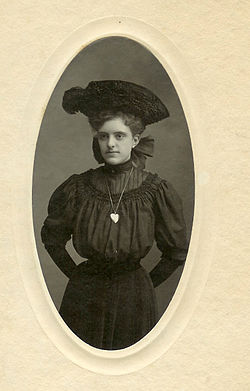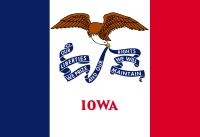- Dixie Cornell Gebhardt
-
Dixie Cornell Gebhardt 
Dixie Cornell Gebhardt in about 1917.[1]Born Dixie Cornell
November 18, 1866
Knoxville, Iowa, U.S.Died October 16, 1955 (aged 88)
Knoxville Iowa, U.S.Known for Designer of Iowa State flag Spouse George Tullis Gebhardt Dixie Cornell Gebhardt (November 18, 1866–October 16, 1955) was a leader of the Daughters of the American Revolution in Iowa during World War I, and was responsible for the design of the Iowa's state flag.[2][3]
At the beginning of the war, Iowa had no state flag, and such a flag would have been expected to be carried by regiments from that state. (As the war progressed, however, it became obvious that regiments comprising men from individual states would no longer be formed.) Gebhardt developed a possible design for an Iowa flag, and it was submitted to Governor William L. Harding and the Iowa Council on National Defense, along with several other designs. Her design was selected, and became the official flag of the state in 1921. [4]
Dixie Cornell was born on November 18, 1866, in Knoxville, Iowa, the daughter of Dr. Norman Riley Cornell and Mary Fletcher Timmonds. She married George Tullis Gebhardt in 1900. The designer of Iowa's state flag died on October 16, 1955, in Knoxville, Iowa, and is honored by a monument at 217 South Second Street in that town.[5]
Dixie Cornell Gebhardt was born as “Jim Dick Cornell.” Her father, Dr. Norman Cornell, named his three daughters after his trotting horses, “Iowa Belle,” “Jim Dick,” and “Jackie.” His daughter, Iowa Belle, the mother of Judge Tom Cornell Whitmore, of Atlantic, Iowa, called herself “Violet Isabel,” which produced a sound close to “Iowa Belle,” but was buried as “Belle” in Knoxville, Iowa.
Jim Dick Cornell, the aunt of Judge Whitmore and great aunt of Charles H. Whitmore, of Rock Island, Illinois, assumed the name “Dixie,” since she did not care for her actual name.
This is written by Tom Cornell Whitmore, born March 13, 1940, a great-grand nephew who knew Mrs. Gebhardt and was told the story of her name and the names of her siblings by his grandfather, Judge Tom Cornell Whitmore, of Atlantic, Iowa, and by his late father, Charles H. Whitmore, of Rock Island, Illinois.
Excerpts from DAR presentation by Iva E. Roorda and Lyle Bruere: Our Iowa flag was designed by Dixie Cornell Gebhardt of Knoxville, while she was State Regent of the DAR. Mrs. Gebhardt collected ideas from many Iowa DAR and spent eight years in determining the final design.
Dixie Gebhardt's design was approved by the DAR Flag Committee in the early part of 1917, and at our State House by Governor William Harding and the State Council of Defense in May of that year. The flag was first used for the Iowa Regiments in World War I (1917 - 1918) for the purpose of identifying Iowa military units at home and "Over There".
Our flag was adopted by Iowa's Legislative body on March 29, 1921. Soon after, Dixie Gebhardt presented the copyright of the design as a gift to Iowa. This copyright may be seen in the archives of the State Historical department in Des Moines.
About the design:
Dixie Gebhardt felt that "Flags are symbols of achievements of the human race." Therefore "Iowa's banner should embrace the history of its domain from the time of its occupation by the Indians; discovery by the French and its purchase from Napoleon I of France by Jefferson; up to its admission into the union down to the present time. All this should be represented in a design so simple that school children and adults could recognize its symbolism and know that it meant Iowa."
White was chosen for the white unwritten page of history at our state's beginning when the Indians -- the original Americans -- lived on the unbroken prairies of Iowa. On the center of this page the Indian's favorite color, red, is used to write IOWA, the Indian word for "Beautiful Land".
On June 17, 1673, Iowa was discovered by the French traders Marquette and Jolliet and remained French territory until 1803, when it was a part of the Louisiana Purchase. The blue, white and red of the Tricolor of France - the first flag to fly over Iowa - is arranged on our flag.
Dixie Gebhardt had a second reason for these colors. The blue portion stands for loyalty, the white stands for purity and the red for courage.
In the center a soaring Eagle carries blue streamers in his beak which read "Our liberties we prize and our rights we will maintain." Dixie Gebhardt cleverly signifies here that we are a part of this nation by combining our national bird with Iowa's state motto.
The standard of the flag may be surmounted by a gold ear of corn and tied with a gold cord and tassels. A gold fringe may be used around the entire banner. The corn and the gold are symbolic of Iowa's agriculture and wealth...wealth of nature and humanity as well as material wealth from agriculture and industry. The finished design reflects Iowa's history of the past, brings us to the present and certainly points to our future.
In 1946, our flag was pictured on a postage stamp commemorating Iowa's 100 years of statehood. In 1956, the Iowa chapters of the DAR presented a portrait of Dixie Gebhardt to be hung in the Governor's mansion.
An Iowa flag was sent to Mrs. Dwight D. Eisenhower while her husband was President of the United States. Mamie Eisenhower said this flag had a personal significance since it was mailed from Knoxville, birthplace of the Iowa flag and especially important to her since it was the flag of the state in which she was born.
Another First Lady, Lou Hoover, was born in Iowa and is buried beside the late President Herbert Hoover at his birthplace at West Branch. The DAR presented the Iowa flag which is flown there on special occasions.
Even Dixie Gebhardt's name and background are complementary to the creation of our flag. She was the daughter of a pioneer Knoxville physician who served as an army surgeon in the American Civil War with the Iowa Infantry. Her mother was from Kentucky and named her Dixie for the Southland.
Dixie Gebhardt was born November 18, 1866, in Knoxville, lived most of her life in Iowa and died at Knoxville, October 16, 1955. Her grave there is marked by the DAR honoring her as the designer of our Iowa flag.
Dixie Gebhardt felt the designing of our state flag was the greatest achievement of her life. The Daughters of the American Revolution promote three objectives: history, education and patriotism. Iowa daughters are proud of Dixie Gebhardt for combining all three objectives into our Iowa flag.[6]
Obituary as written by niece for Knoxville paper: Dixie May Cornell, daughter of Dr. Norman Riley Cornell, and Mary Timmonds Cornell, was born Nov. 18, 1866 into one of the outstanding families of Knoxville, and died at the Collins Memorial Hospital in this city Oct. 16 at the age of 88 years, 10 months and 28 days.
She was named "Dixie" by her mother for the Southland and her Green Valley home in Kentucky, but was frequently called "Dickie" by her northern friends and relatives. She grew up in Knoxville with the exception of a year spent at the Visitation School for Girls in Ottumwa, Iowa in 1883. She was graduated from Knoxville Public Schools in 1885. After teaching for a short time, she came home to care for her invalid and aging parents.
In June 1900 she was married to George Tillis Gebhardt of Knoxville who preceded her in death.
Mrs. Gebhardt was a member of the First Methodist Church at Knoxville, and although unable to attend services for some years, she frequently expressed her belief in Christ and enjoyed and appreciated the home visits of her pastors.
Originally a member of Abigail Adams Chapter, DAR, of Des Moines, she became the organizer and charter member of Mary Marion Chapter, DAR, at Knoxville in 1917. She served as Iowa's State Recording Secretary of DAR, 1913-1916, and as the State Regent 1916-1918, during which time she designed the State Flag which was approved by Iowa's Governor and Council of Defense, May 1917. This design was chosen and used for the Iowa Regimental Flag in World War I (1917-1918) for the purpose of identifying Iowa Military units at home and Over There. It was adopted by Iowa's Legislative body March 1921, as Iowa's Official State Flag. The same year, 1921, Mrs. Gebhardt applied for and received a copyright of her design and presented the copyright as a gift to Iowa, her native state. She was called by Governor Harding, "Iowa's Betsy Ross".
On March 20, 1887, Mrs. Gebhardt became a member of Chapter M, PEO, of Knoxville. During her long period of membership in the Sisterhood-longer than that of any member now living-she was President of Chapter M and also held offices in the State and Supreme Chapters. Many kindnesses and courtesies shown her by Chapter M after she could no longer attend the Chapter meeting brightened her shut-in days.
She worked for several years for the Red Cross at the U.S. Veterans Hospital in Knoxville, and later as a DAR Genealogist at Continental Hall in Washington, D.C. She was also active in the Democratic Party.
She loved Knoxville, her home, her relatives, and her friends, young and old, including the nurses who cared for her during the last year and a Half in the Collins Memorial Hospital. She had out-lived her immediate family, and she missed the loved ones who had gone on before her and looked forward to the reunion.
She is survived by two nephews, Dr. Rodney I. Cornell of Los Angeles, Calif. and Judge Norman R. Hayes of Knoxville; three nieces, Mrs. George E. Chapman of Shelton, Nebraska, Mrs. Joe M. Johnston and Miss Isabel C. Hayes of Knoxville, and a number of grand and great-grand nephews and nieces.
Funeral services were held from the Bybee and Davis Funeral Home on Oct. 19, at 2 p.m. with Rev. M. D. Summerbell and Rev. F.W. Dieterich officiating. Burial was in Graceland Cemetery.[7]
References
- ^ http://hdl.loc.gov/loc.rbc/rbpe.01905000 U.S. Library of Congress, An American Time Capsule: Three Centuries of Broadsides and Other Printed Ephemera. History of the flag. 1918. Printed Ephemera Collection; Portfolio 19, Folder 50.
- ^ D.A.R. (1916). "Daughters of the American Revolution Magazine", p. 198.
- ^ Shearer, Benjamin F. (2001). State Names, Seals, Flags, and Symbols: A Historical Guide. Greenwood Press. 495 pp. ISBN 0313315345
- ^ Shankle, George Earlie. (1971). State Names, Flags, Seals, Songs, Birds, Flowers, and Other Symbols. Reprint Services Corp, revised ed.
- ^ The Iowa State Flag
- ^ Roorda, Iva and Lyle Bruere. (1972). "History of the Iowa State Flag" presentation for DAR from hand-written copy in family collection held by N. Toll
- ^ Hays, Isabel C. (1955). Hand-written original obituary from family collection held by N. Toll.
Categories:- 1866 births
- 1955 deaths
- People from Marion County, Iowa
- Vexillographers
- Flag designers
- Daughters of the American Revolution
Wikimedia Foundation. 2010.


